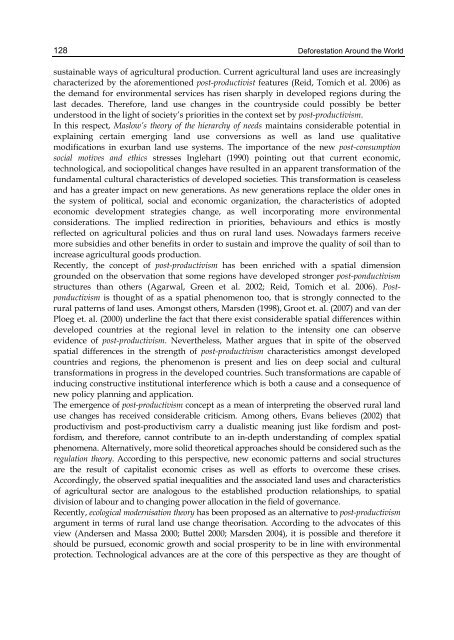DEFORESTATION AROUND THE WORLD - India Environment Portal
DEFORESTATION AROUND THE WORLD - India Environment Portal
DEFORESTATION AROUND THE WORLD - India Environment Portal
You also want an ePaper? Increase the reach of your titles
YUMPU automatically turns print PDFs into web optimized ePapers that Google loves.
128<br />
Deforestation Around the World<br />
sustainable ways of agricultural production. Current agricultural land uses are increasingly<br />
characterized by the aforementioned post-productivist features (Reid, Tomich et al. 2006) as<br />
the demand for environmental services has risen sharply in developed regions during the<br />
last decades. Therefore, land use changes in the countryside could possibly be better<br />
understood in the light of society’s priorities in the context set by post-productivism.<br />
In this respect, Maslow’s theory of the hierarchy of needs maintains considerable potential in<br />
explaining certain emerging land use conversions as well as land use qualitative<br />
modifications in exurban land use systems. The importance of the new post-consumption<br />
social motives and ethics stresses Inglehart (1990) pointing out that current economic,<br />
technological, and sociopolitical changes have resulted in an apparent transformation of the<br />
fundamental cultural characteristics of developed societies. This transformation is ceaseless<br />
and has a greater impact on new generations. As new generations replace the older ones in<br />
the system of political, social and economic organization, the characteristics of adopted<br />
economic development strategies change, as well incorporating more environmental<br />
considerations. The implied redirection in priorities, behaviours and ethics is mostly<br />
reflected on agricultural policies and thus on rural land uses. Nowadays farmers receive<br />
more subsidies and other benefits in order to sustain and improve the quality of soil than to<br />
increase agricultural goods production.<br />
Recently, the concept of post-productivism has been enriched with a spatial dimension<br />
grounded on the observation that some regions have developed stronger post-ponductivism<br />
structures than others (Agarwal, Green et al. 2002; Reid, Tomich et al. 2006). Postponductivism<br />
is thought of as a spatial phenomenon too, that is strongly connected to the<br />
rural patterns of land uses. Amongst others, Marsden (1998), Groot et. al. (2007) and van der<br />
Ploeg et. al. (2000) underline the fact that there exist considerable spatial differences within<br />
developed countries at the regional level in relation to the intensity one can observe<br />
evidence of post-productivism. Nevertheless, Mather argues that in spite of the observed<br />
spatial differences in the strength of post-productivism characteristics amongst developed<br />
countries and regions, the phenomenon is present and lies on deep social and cultural<br />
transformations in progress in the developed countries. Such transformations are capable of<br />
inducing constructive institutional interference which is both a cause and a consequence of<br />
new policy planning and application.<br />
The emergence of post-productivism concept as a mean of interpreting the observed rural land<br />
use changes has received considerable criticism. Among others, Evans believes (2002) that<br />
productivism and post-productivism carry a dualistic meaning just like fordism and postfordism,<br />
and therefore, cannot contribute to an in-depth understanding of complex spatial<br />
phenomena. Alternatively, more solid theoretical approaches should be considered such as the<br />
regulation theory. According to this perspective, new economic patterns and social structures<br />
are the result of capitalist economic crises as well as efforts to overcome these crises.<br />
Accordingly, the observed spatial inequalities and the associated land uses and characteristics<br />
of agricultural sector are analogous to the established production relationships, to spatial<br />
division of labour and to changing power allocation in the field of governance.<br />
Recently, ecological modernisation theory has been proposed as an alternative to post-productivism<br />
argument in terms of rural land use change theorisation. According to the advocates of this<br />
view (Andersen and Massa 2000; Buttel 2000; Marsden 2004), it is possible and therefore it<br />
should be pursued, economic growth and social prosperity to be in line with environmental<br />
protection. Technological advances are at the core of this perspective as they are thought of

















